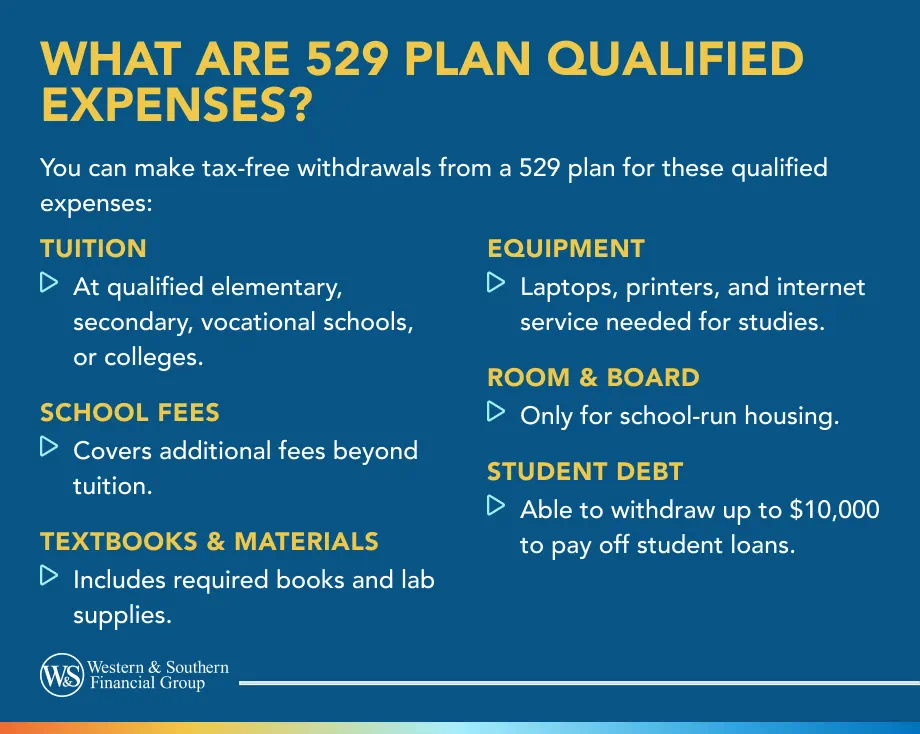

Table of Contents
Key Takeaways
- Tax-free 529 plan withdrawals cover tuition, fees, books, and equipment.
- Room and board are covered, only for housing ran by the school.
- Transportation, cell phone plans, and athletics fees are not eligible.
- Up to $10,000 can be used for private school tuition.
- Nonqualified expenses trigger a 10% tax penalty on earnings.
If you'd like to put money aside for a loved one's education, a 529 plan may help grow your savings. When you spend the money on 529 plan qualified expenses, your withdrawals are tax-free. There are limits on what you can use the money for. Here's what you should know.
What Are 529 Qualified Expenses?
You can make tax-free withdrawals from a 529 plan as long as you spend the money on qualified expenses. These expenses include:
- Tuition: Must be at a qualified elementary school, secondary school, vocational school, college, university or other accredited postsecondary educational institution.
- School fees: You can use the money in a 529 plan to help cover other school fees on top of tuition.
- Textbooks & materials: This includes items such as required books for classes and lab supplies.
- Equipment: If the student needs equipment such as a laptop, printer or internet service, you can pay for these out of the 529 plan.
- Room & board: If the student lives in housing that is run by the school, then the entire amount can be covered by the 529 plan.
- Student debt: Under the SECURE 2.0, 529 plan holders are able to withdraw up to $10,000 tax free to put toward their own student loan debt or that of their grandchildren, children or spouses.
What Expenses Are Not Eligible for 529 Plan Money?
Not all school-related costs count as 529 plan qualified expenses. Here are some to keep in mind.
- Off-campus housing that costs more than a dorm: The university or college sets an allowance for how much room and board should cost for their students. This is the maximum you can withdraw per year out of a 529 plan for housing and food. If the student lives off campus and spends more than the university estimate, anything over the limit cannot come from the 529 plan.
- Transportation: Getting to school can be expensive, especially if the student needs to fly. But you cannot use the 529 plan to cover these costs or any commuting expenses during the school year.
- Cell phone plans: While a 529 plan can be used for some technology like laptops, it doesn't include cell phones.
- Athletic fees: You can use your 529 plan to cover most school fees but not anything related to athletics such as a fee to use the school gym or to sign up for a sports team.
- Insurance: Students need to pay for their health insurance without using 529 funds.
Can 529 Plan Funds Be Used to Pay for Elementary or High School?
A 529 plan isn't just for paying for college tuition. According to the IRS, you can also use the money to pay for tuition at a private elementary or high school.1 Only tuition applies at this level of education, and you can't use a 529 plan for any of the other categories like room and board or equipment.
There's also a limit on how much you can spend per year when using a 529 plan for elementary or high school. You can withdraw up to $10,000 yearly tax-free for private elementary or high school tuition. You can withdraw up to $10,000 yearly tax-free for private elementary or high school tuition.
What If You Use 529 Plan Funds for Nonqualified Expenses?
You will incur a 10% tax penalty if you spend the money in your 529 plan on nonqualified expenses. However, you do have access to the funds. The penalty only applies to your investment earnings.
Are There Exceptions to the 529 Plan Tax Penalty?
What happens if you save too much and the student finishes school without using all the money in your 529 college savings plan? To potentially avoid the penalty, you could transfer the account to another beneficiary in your family. Then you could help pay for another family's member's qualified expenses with tax-free withdrawals. You can also roll the money to a Roth IRA under certain provisions.
As you plan your savings budget for college, it could help to keep these rules in mind. That way you can set aside money for qualified 529 plan expenses, and then save for everything else using other accounts.
Frequently Asked Questions
Can I use my 529 plan to pay for student loan debt?
Yes, but only a certain amount. Under the SECURE 2.0 Act, holders of 529 plans can withdraw up to $10,000 to pay off their own student debt or that of their spouses, parents or grandparents.
Are there any income limits for contributing to a 529 plan?
There are no federal income limits for contributing to a 529 plan, and most states also do not have income limits. However, some states offer state income tax deductions for 529 plan contributions, and these deductions may have income limits. It's important to check the rules for your specific state's 529 plan.
Can grandparents contribute to a 529 plan for their grandchild?
Yes, grandparents can contribute to a 529 plan for their grandchild. Contributions made by grandparents are considered gifts, and as such, may have tax implications for both the giver and receiver. Grandparents should consult with a financial advisor or tax professional for advice on the best approach for contributing to a grandchild's 529 plan.
Sources
- Tax Benefits for Education. https://www.irs.gov/pub/irs-pdf/p970.pdf.














